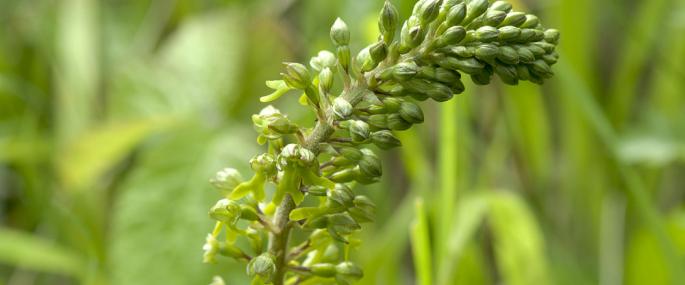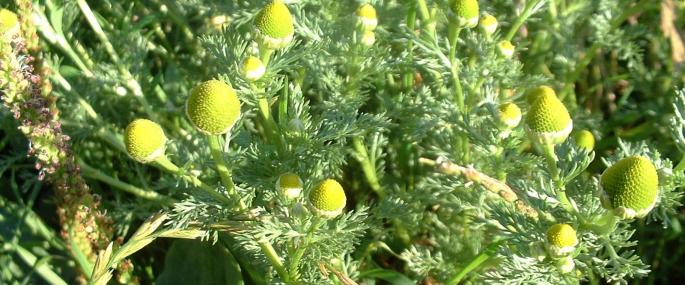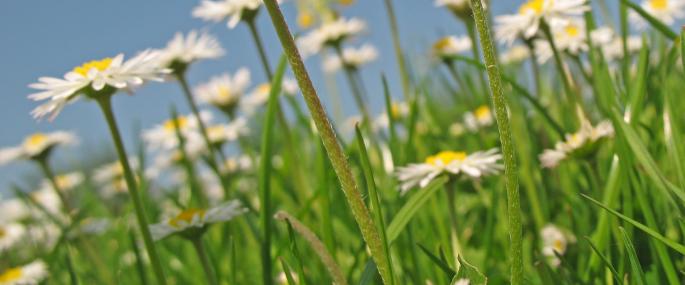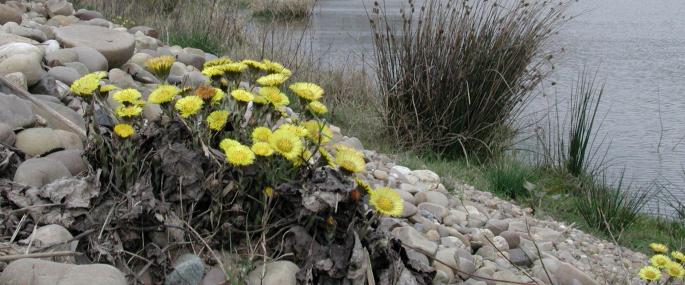Bird's-nest Orchid
The Bird's-nest orchid is a very strange plant: leafless and without the green chlorophyll of other plants that enable them to gain energy from sunlight through photosynthesis, it grows as a parasite on the roots of trees, gaining its nutrients from its host. Usually found in woodland, particularly under Beech trees, this almost sickly looking, yellow plant appears from May to July.
The Wildlife Trusts manage many woodland nature reserves sympathetically for a range of wildflowers including various orchids. A mix of coppicing, scrub-cutting, ride maintenance and non-intervention helps many flowers and plants to thrive and keeps others that are more invasive under control. You can help too: volunteer for your local Wildlife Trust and you could be involved in everything from traditional forest crafts to raising awareness about woodland wildlife.
Twayblade
The Twayblade is a medium-sized orchid that can be easily overlooked despite being one of our commonest species, while Common Spotted is more abundant and more widespread. Common in the woodlands, scrub and grasslands of calcareous soils, its flower spike carries a very loose cluster of yellow-green flowers that are not as showy as some of the other, more exotic-looking orchids. It is in bloom from May to July.
The Wildlife Trusts manage many woodland nature reserves sympathetically for a range of wildflowers including various orchids. A mix of coppicing, scrub-cutting and ride maintenance opens up the woodland floor to the sun, helping many flowers and plants to thrive and keeping others that are more invasive under control. You can help too: volunteer for your local Wildlife Trust and you could be involved in everything from traditional forest crafts to raising awareness about woodland wildlife.

Greater Burdock
Like many of our native plants, Greater Burdock is an excellent source of nectar and pollen for all kinds of insects including bees, wasps and butterflies. To encourage wildlife into your garden, try planting native flower species in your borders to provide a 'nectar-cafe'. To find out more about wildlife-friendly gardening, visit our Wild About Gardens website: a joint initiative with the RHS, there's plenty of facts and tips to get you started.

Oxeye Daisy
A typical grassland plant, the Oxeye Daisy thrives on roadside verges and waste grounds, as well as in traditional hay meadows and along field edges deliberately looked after for wildflowers - swathes of gently swaying Oxeye Daisies can turn a field or roadside white in summer. Its large blooms appear from July to September and are so bright that they appear to 'glow' in the evening, hence the common names of 'Moon Daisy' and 'Moonpenny'.
Once awash with wildflowers and alive with insects, our hay meadows have been drained, damaged and destroyed as a result of agricultural intensification; more than 95% of our wildflower meadows have been lost in recent years. Without care, those meadows that are left can quickly become overgrown, pushing out wildflowers such as Oxeye Daisies. The Wildlife Trusts look after many meadow habitats using traditional methods, such as hay-cutting, reseeding and grazing, for the benefit of local wildlife. We are also working closely with farmers and landowners to promote wildlife-friendly practices in these areas. You can help too: volunteer for your local Wildlife Trust and you could be involved in everything from stockwatching to surveying meadow flowers.
Tansy
Tansy is an aromatic plant of disturbed ground, rough grasslands, riverbanks and roadside verges. It has fern-like foliage and yellow flower heads that appear in clusters from July to October. It has a long history of use for medicinal purposes and was cultivated by the ancient Greeks. Now, many forms are available as decorative garden varieties.
Although they sometimes don't look especially wildlife-friendly, our roadside verges and waste grounds can provide valuable habitats for all kinds of plants and animals. The Wildlife Trusts get involved in different projects to help make these places as beneficial for wildlife as possible. We have a vision of a 'Living Landscape': a network of habitats and wildlife corridors across town and country, which are good for both wildlife and people. You can support this greener vision for the future by joining your local Wildlife Trust.
Hemp-agrimony
Hemp-agrimony is a tall plant found in damp grassland, marshes, fens and wet woodlands, and along riverbanks. The frothy, pinkish flower clusters appear from July to September and are very attractive to all kinds of insects including butterflies like the Small Tortoiseshell and Red Admiral. Its common name comes from the resemblance of its leaves to Hemp or Cannabis, although it is not related to it.
Human activity, including the drainage of land for agriculture and development, has resulted in the disappearance of many of the UK's wetlands. The Wildlife Trusts are working closely with planners, developers and farmers to ensure our wetlands are protected. You can help too: add native plants and flowers, such as Hemp-agrimony, to a wildlife-friendly pond and its margins, and provide shelter for amphibians and nectar for insects. In partnership with the RHS, The Wildlife Trusts' Wild About Gardens initiative can help you plan your wildlife garden.

Yarrow
Yarrow is a tough plant of many grasslands, from lawns to verges and meadows; clusters of white, flat-topped flower heads appear from June to November. Yarrow has been used to help restore arable land to grassland by sowing it along with other natives.
Some of our most abundant species are often treated as 'weeds' when they appear in the garden. Yet they can be extremely beneficial to wildlife, providing food for nectar-loving insects and shelter for minibeasts. Try leaving wilder areas in your garden and see who comes to visit... To find out more about wildlife-friendly gardening, visit our Wild About Gardens website: a joint initiative with the RHS, there's plenty of facts and tips to get you started.
Pineappleweed
The bright green, feathery leaves and yellow flower heads of Pineappleweed can be seen on bare, disturbed ground, such as paths and pavements, roadsides and tracks. Introduced into the UK during the late 19th century, its rapid spread has been attributed to growth of motor transport - the seeds being picked up on tyre treads, along with the mud of the then untarmaced roads, and being deposited miles away as rain washed them off.
Pineappleweed is an introduced species that has become widespread and naturalised in the UK over many years without much cause for concern. However, the effects of introduced species are not always as benign. The Wildlife Trusts work with researchers, scientists and other conservationists to monitor changes in our native wildlife to determine the effects of environmental change, such as the introduction of new species or climate change. You can help: volunteer for your local Trust and you'll be able to monitor populations and survey habitats, adding to a growing bank of data.

Daisy
Perhaps one of the most familiar flowers of all, the humble Daisy can be seen flowering almost all year-round. Their persistent and widespread growth, heralding the arrival of spring to our gardens, has resulted in children using them to make necklaces (Daisy chains) and adults desperately trying to rid their lawns of them.
Many of our so-called 'weeds' are beneficial to wildlife, providing food for nectar-loving insects and shelter for minibeasts. Try leaving wilder areas in your garden, such as patches of Daisies and Red Clover in your lawn and Stinging Nettles near the compost heap, and see who comes to visit... To find out more about wildlife-friendly gardening, visit our Wild About Gardens website: a joint initiative with the RHS, there's plenty of facts and tips to get you started.

Colt's-foot
A common and creeping perennial of bare, damp or disturbed ground, Colt's-foot can be found on waste ground, field edges and roadside verges. The sun-yellow flower heads appear as early as February, and well before the hoof-shaped leaves (hence the common name). Colt's-foot continues to brighten up rough ground until April.
Some of our most abundant species are often treated as 'weeds' when they appear in the garden. Yet they can be extremely beneficial to wildlife, providing food for nectar-loving insects and shelter for minibeasts. Try leaving wilder areas in your garden and see who comes to visit... To find out more about wildlife-friendly gardening, visit our Wild About Gardens website: a joint initiative with the RHS, there's plenty of facts and tips to get you started.
